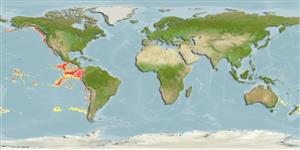Pallenopsis comosa Stock, 1975
| Native range | All suitable habitat | Point map | Year 2050 |

|
| This map was computer-generated and has not yet been reviewed. |
| Pallenopsis comosa AquaMaps Data sources: GBIF OBIS |
Upload your photos
Google image |
No photo available for this species.No drawings available for Phoxichilidiidae.
Google image |
No photo available for this species.
Classification / Names Common names | Synonyms | CoL | ITIS | WoRMS
Pycnogonida | Pantopoda | Phoxichilidiidae
Environment: milieu / climate zone / depth range / distribution range Ecology
Benthic; depth range 2086 - 3300 m (Ref. 2157). Tropical
Distribution Countries | FAO areas | Ecosystems | Occurrences | Introductions
Eastern Pacific: Peru and USA.
Length at first maturity / Size / Weight / Age
Maturity: Lm ? range ? - ? cm
Short description Morphology
Proboscis inflated at both midpoint and distal end. Species has two or three major heel spines larger than sole spines but not nearly as large as heel spines of Pallenopsis californica. Abdomen very long; tibiae with rows of long, slender, lateral setae, and cement gland tube nearly as long as femoral diameter. Chelae conspicuously smaller relative to those of other species (Ref. 2157, p. 4).
Abyssal (Ref. 19).
Life cycle and mating behavior Maturity | Reproduction | Spawning | Eggs | Fecundity | Larvae
Members of the class Pycnogonida are gonochoric and sexually dimorphic. During copulation, male usually suspends itself beneath the female. Fertilization occurs as the eggs leave the female's ovigers. Males brood the egg masses until they hatch. Life cycle: Eggs hatch into protonymphon larva then to adults.
Main reference
References | Coordinator | Collaborators
Child, C.A. 1994. (Ref. 2157)
IUCN Red List Status (Ref. 130435)
CITES status (Ref. 108899)
Not Evaluated
CMS (Ref. 116361)
Not Evaluated
Threat to humans
Human uses
| FishSource |
Tools
More information
Internet sources
BHL | BOLD Systems | CISTI | DiscoverLife | FAO(Publication : search) | Fishipedia | GenBank (genome, nucleotide) | GloBI | Gomexsi | Google Books | Google Scholar | Google | PubMed | Tree of Life | Wikipedia (Go, Search) | Zoological Record
Estimates based on models
Preferred temperature
(Ref. 115969): 1.7 - 2, mean 1.8 (based on 30 cells).
Price category
(Ref. 80766):
Unknown.


